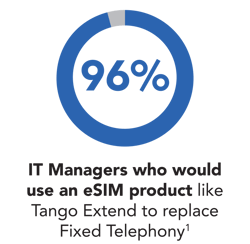April 23, 2024
It has been a long time coming. But we now see signs that going fully mobile is the preferred way of communications for business users.
If you make any business calls outside the office – like a frontline worker always on the go or a knowledge worker with a hybrid work schedule – then the odds are that you use your personal mobile phone for work at some point.
That’s what makes the latest data from Cavell Group so compelling.
Cavell surveyed over 800 frontline workers in the USA, UK, Germany, France, Spain, and the Netherlands. All companies had over 50 employees and most were in healthcare-related jobs.
The research, commissioned by us and completed earlier this year, shows that half of surveyed frontline workers in the USA, UK and EU are already using their personal mobile phones for work.
This practice is well accepted by employers - and in the same survey of 800 IT managers across many industries, over 75% said they permit personal devices to be used for work.
And perhaps most tellingly, over 96% said they would allow new business eSIMs on mobile phones to replace traditional desk phones.
That’s a complete game-changer for business communications.
It shows that IT managers recognize this as a simple way they can meet users needs, while increasing productivity and saving costs. It also shows the willingness of workers to adopt technology they already carry with them - and the convenience and ease of use it offers.
In a recent OMDIA study, over 37% of IT managers said that it was vitally important to enable communications and collaboration via mobile devices. Another 32% said it was important.
The Shift to Mobile
Not only are employers ready to cut the cord and end the desk phone era, but they and their employees are willing to do so with Bring Your Own Device (BYOD) as the key to Mobile Unified Communications.
The New Workstyles
The trend is especially important for companies who employ frontline workers, such as those “deskless” workers who conduct in-home repair and installation services, healthcare services, delivery and other jobs that have them on the move.
But it is just as important when you consider the massive changes in how knowledge workers do their jobs.
The switch to remote working during the pandemic has evolved into hybrid work models that permit knowledge workers to operate flexibly, in the office part of the time and working from home part of the time.
As working has become more flexible, the communications tools we use need to become more flexible.
That’s why these workers are happy to use their personal mobile phones as the preferred business communications device they carry with them everywhere.
According to Cavell, there were over 8.5 million mobile-enabled users of cloud communications at the end of 2023. This is expected to more than double to 19 million by 2028.
When businesses move their collaboration and telephony to the cloud, they have to make choices of what technology to provide to their end users. Gartner predicts that most businesses will reduce the number of office phones by 30% to 80% when migrating to a new telephony platform.
Cloud telephony is gaining great pace in the market now. More than two-thirds of the workers we surveyed are using collaboration tools such as Microsoft Teams for their communications. There are now over 300 million daily teams users and over 80 million Teams Phone licenses in the market today.
By 2028 there will be over 5.1 billion people with a smartphone. So mobile use for business communications is set to become the norm over the coming decade.
Managing large scale deployments of mobile telephony requires fast remote provisioning that is easy for remote workers to understand. That’s where new eSIM technology comes in.
The eSIM Mobile Business Line
About half of mobile phones currently in the market are eSIM capable, meaning that the days of the old fiddly plastic SIM cards are numbered. For device manufacturers they save space and cost in the device, and for some years now, most phones can support at least one active eSIMs. Apple is leading the way here, and in fact the iPhone 13 can support two eSIMs and the iPhone 14 no longer supports physical SIM cards.
Our survey revealed that around 90% of the surveyed workers were willing to allow an employer to install and control an additional eSIM with a business line on their mobile phones as long as their personal SIM and lines would remain entirely separate and private. They also liked the feature that allows them to turn off business calls after hours and on holidays.
This is why our Tango Extend solution has received so much attention lately.
Extend is the industry’s first solution to offer a business eSIM that can be easily installed in the spare slot in a BYOD smartphone to create “dual personas,” meeting the need to completely separate the identity and use of the personal and business numbers.
So if you are an employee on the go and you need to make a business call, there’s no app to open. It’s as simple as pulling up your phone’s native dialer or just selecting a business contact. Your contacts are tagged as personal or business and the phone will automatically choose the right line to use for every call.
The business allocates the business number and manages the policies for business calls using the eSIM and calls can even be recorded for records retention and communications monitoring compliance.
Tango Extend enables many cloud collaboration solutions, including Microsoft Teams, to be used natively on mobile phones. Existing landline Teams numbers can be used, without the need for apps or Mobile Device Management (MDM) control. By using the dedicated high quality voice channels of modern mobile networks, Tango Extend provides far superior business-class calling experiences through the native phone dialer.
BYOD is Ready for Business
It’s a win-win.
Employees can use the devices they know and love, and enjoy the best quality business calls using native mobile communications, without it interfering with their personal use.
Their employers can allocate existing landline numbers to the eSIMs and retain control over mobile UC without the huge costs of providing company-owned phones. They can reduce the number of desk phones too (and reduce their carbon footprints) and retain policy control and apply call recording and even use AI to summarize and log all remote worker calls.
Featuring the most advanced implementation of fixed mobile convergence technologies, Tango Extend supports many use cases for a distributed workforce including frontline workers and knowledge workers. Tango Extend is used for Mobile Unified Communications, mobile workforce communications, and programs for remote working, work from home, telecommuting and business continuity.
Get in touch today to learn how Tango Extend will make BYOD truly business ready for your company and support the move to “Mobile Only” communications.
